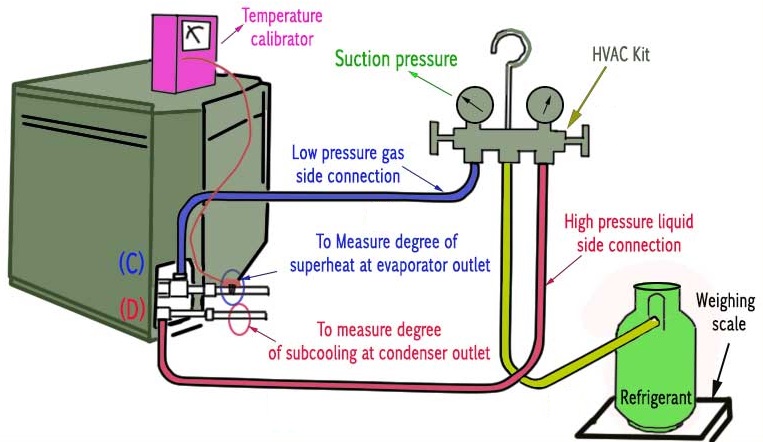The purpose of this method statement is to establish a standard ac maintenance procedure for refrigerant compressor replacement in air conditioning units and any other refrigeration system. This method will also serve as a guideline for training new employees dealing with Air conditioning unit Maintenance activity.
Scope of this standard procedure covers all equipment’s which use refrigerant compressor and is directly involve in A/C and refrigeration equipment. The equipment’s include but not limited to Chiller Units, Package Units, Split AC Units, Cold Store Units, Window Type AC etc.
Tools & Equipment’s
- gas cylinder,
- gauge manifold,
- brazing set,
- brazing rod,
- flaring tool,
- spanner,
- adjustable wrench,
- vacuum pump,
- clamp ammeter,
- screw driver
It is the responsibility of the maintenance technician to replace the damage compressor either with a new one or a used but working compressor unit. Technician must be competent enough and has a complete background in Air-conditioning system maintenance to avoid any further damage on the equipment. Refrigerant compressor is considered as the heart of the air-conditioning system therefore care should be taken during replacement works. The Supervisor and the maintenance engineer shall assure the implementation of this maintenance procedure during the maintenance works.
Compressor Replacement Procedure
Prior to the start of work, wear safety shoes, goggles and gloves. It is also important to place a fire extinguisher near the working area during brazing works.
Make sure the availability of all tools and equipment’s necessary for replacing the refrigerant compressor like gas cylinder, gauge manifold, brazing set, brazing rod, flaring tool, spanner, adjustable wrench, vacuum pump, clamp ammeter, screw driver, etc.
Remove the refrigerant gas from the system.
Dismantle the old compressor unit either by cutting the suction and discharge pipe or removing the flare connection.
Use dry nitrogen to push some of the contaminants out of the system by simply attaching the nitrogen regulator to one of the lines and allowing it to blow out the other. Do not exceed the system working pressure with nitrogen. Without compressor in the system, you can safely use 250 psig for high pressure refrigerant systems.
Disconnect the pipeline before the expansion valve device where a liquid line filter can be installed later.
Purge the Nitrogen through the liquid line toward the compressor.
Disconnect the nitrogen after pushing off all contaminants on this point.
Connect the nitrogen to the expansion device side of the liquid line. This line may be purged toward the compressor suction line.
Install the liquid line filter just before the metering device (expansion valve) to prevent contamination from restricting the refrigerant flow.
Install the new refrigerant compressor by either brazing the suction and discharge line to their corresponding connections or by using flare joint connection.
If you are installing old compressor, change the oil first with specified grade (either 3GS or 4GS).
Conduct leak testing using standing pressure test procedure
Isolate the compressor by front seating the suction and discharge valve of the compressor.
Charge the system with dry nitrogen until pressure reaches 150 psig. Do not pressurize any system above its working pressure as written on the label of the equipment.
Let the system stand for a while and check the pressure gauge, if the reading falls, there is a leak.
Conduct system evacuation using a vacuum pump.
Charge the system with refrigerant as per refrigerant charging procedure. Make sure that suction and discharge pressure will be 60 to 69 psig and 250 to 275 psig.
Start the system and keep it running as long as practical to circulate the refrigerant through the filter drier.
Conduct current reading on the compressor and on the fan motor.
Check the discharge air temperature of the evaporator if cooling is evident.
Prepare report and list all details and equipment parameters after work done.
External References
Refrigeration and Air-conditioning Technology, 3rd Edition By: William C Whitman & William M. Johnson